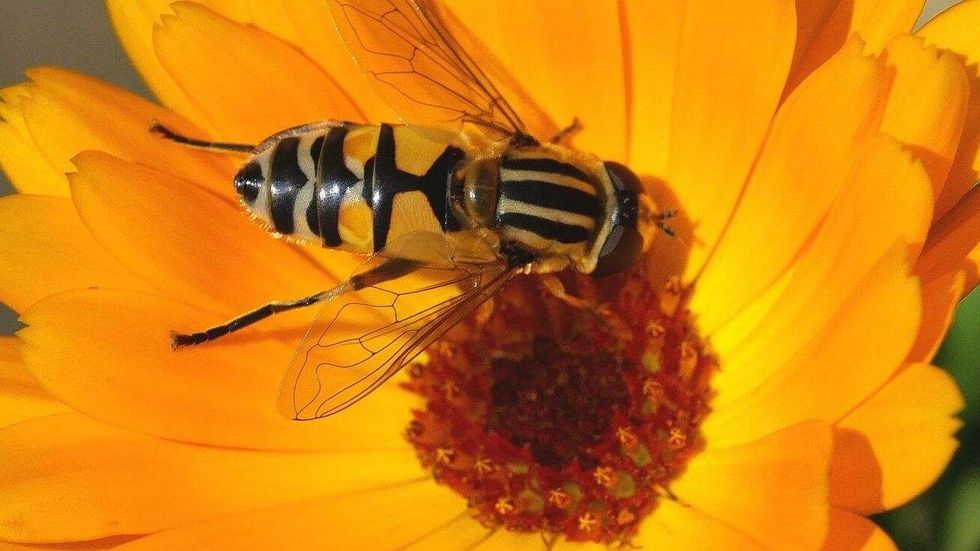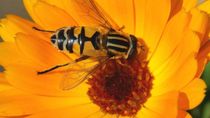Hoverfly species are found in all nooks and corners of the world except deserts or high altitude places like cliffs and mountains, or very cold places. It is studied that there are around 200 genera and 6000 species of hoverflies reside on this planet.
Hoverflies, also called flower flies or syrphid flies, are species similar to wasps and bees. They have similar body colors to bees, which are mainly of yellow and black.
They have small hairs on their body. The legs are long and thin, and the wings are tinted and transparent. They mainly feed on nectar and pollen, but some hoverfly species feed on dead insects too.
The larvae mainly feed on aphids and prove beneficial for plants. Adults can live an average life of 12-15 days.
This was just a small introduction to this insect. In the sections below, there are a lot of interesting and funny facts about hoverflies. Enjoy!
For more relevant content, read our articles on dragonfly facts and ladybird facts for kids.
Hoverfly Interesting Facts
What type of animal is a hoverfly?
Hoverflies are flies like wasps commonly seen hovering on flowers in search of nectar and pollen.
What class of animal does a hoverfly belong to?
Hoverflies belong to the class Insecta. They construct the insect family Syrphidae and belong to the order Diptera. There are around 6,000 species and 200 genera of hoverflies in this world.
How many hoverflies are there in the world?
There is no exact answer to this question. Hoverflies or syrphid flies make up the family Syrphidae, and there are around 6,000 species and 200 genera of hoverflies residing in this world. So it is impossible to count them in exact numbers.
Where does a hoverfly live?
Hoverflies are commonly seen in gardens hovering flowers to flowers. Some hoverflies are aquatic in nature and found in still water bodies like ponds and in lake portions. They nest in trees or other safe places.
What is a hoverfly's habitat?
Hoverflies are commonly found across the whole world. However, they don't happen in extreme environments such as deserts or very high altitudes or in very cold regions like the Antarctic. There are 200 genera and 6k species of hoverfly who are common in all suitable parts of the world.
Who does hoverfly live with?
Hoverflies like bees and wasps live in colonies and can often be seen hovering from flowers to flowers in gardens.
How long does a hoverfly live?
The lifespan of hoverfly adults can be for few days and can extend to a few weeks. The average lifespan for hoverflies is estimated between 12-15 days. However, it is recorded that some species of hoverflies can live up to 50 days.
How do they reproduce?
Most of the hoverfly larvae are carnivorous in nature. Hoverflies feed on pollen and nectar in order to gain strength for laying eggs. Male hoverflies are seen buzzing around the female in order to attract her.
If the female gets attracted, they mate, and the male fertilizes her eggs. After fertilizing, females look for appropriate sites to lay their eggs. Eggs are generally laid in areas that supply enough food for their larvae.
The larvae are mostly carnivorous and feed on aphids. Larvae spawn near aphid colonies and feed on them. When the larvae are ready to pupate, they tend to attach themselves to leaves.
And finally emerging into beautiful hoverflies. Hoverfly larvae can be beneficial to plants as they feed on aphids, which cause harm to plants. So when hoverfly larvae are present on a plant, don't use insecticides or any sort of chemicals.
What is their conservation status?
Hoverflies inhabit the world in adequate numbers. They can be often seen hovering in gardens. There are 200 genera and around 6000 species of hoverflies living on this planet. The maximum of these species falls under the Least Concern conservation category.
Hoverfly Fun Facts
What do hoverflies look like?
Hoverflies, also called flower flies or syrphid flies, are small insects that look like bees or wasps. They are common in all nooks and corners of the world except in extreme environments.
They are mostly yellow in color and have some beautiful buzzing wings. Now there are around 6000 hoverfly species in this world, so naturally, they differ in size.
The range of differentiation is not that high as all of them are similar looking. Their body is covered with a cuticle which saves them from foreign attacks.
The body color in most species is black and yellow patterns giving them an appearance similar to bees and wasps. They have long and thin legs, which give them high mobility.
Their wings are big and transparent and can be tinted sometimes, and the veins are lightly visible on the wings. The cuticle on their face is dark in color and has wrinkles on them.
The underbody is lighter yellow and white in color and has a glossy cuticle over it. Some adults have hair-like structures on their bodies and face.
The average body size of hoverflies ranges between 0.2-0.6 in (0.5-1.5 cm), and their body weight can be of a negligible amount. There are around 6000 hoverfly species, each being special in its own way.

How cute are they?
They are small insects in the family Syrphidae and can be seen buzzing on flowers in gardens. They are harmless and beneficial to humans. They are very cute and adorable.
How do they communicate?
There is exact information available on how hoverflies communicate, but it is considered that they communicate through body language.
How big is a hoverfly?
Hoverflies are small insect species similar to bees and wasps. Their body size can vary between 0.2-0.6 in (0.5-1.5 cm). They are seen hovering over flowers in gardens. They make up the family Syrphidae. They are very much similar to the honey bee in size.
How fast can a hoverfly fly?
A hoverfly flies from one flower to another at an average speed of 7.4 mph (12 kph).
How much does a hoverfly weigh?
Hoverflies or flower flies are small insect species like bees who are 0.2-0.6 in (0.5-1.5 cm) long. They are very small and have a negligible amount of weight.
What are the male and female names of the species?
There are no separate names given to the male and female hoverflies. They are of the same size and shape and have the same color patterns.
What would you call a baby hoverfly?
Baby hoverflies are called maggots. They are carnivorous and commonly eat aphids. That's why hoverflies are considered good. Aphids are destructive to plants, and these insects feed on them, making them beneficial for the plant.
What do they eat?
Maggots are carnivorous and feed on aphids and other smaller insects. But hoverflies are purely herbivorous and only feed on pollen and nectar. But there are some species of hoverflies who feed on dead insects, and some maggots are herbivorous too.
Are they dangerous?
Not really. Hoverflies are not dangerous to humans as they have no venom in them. They might act as if they are going to sting you, but that's just a simple mimicry of bees that they perform in order to save themselves from danger.
Would they make a good pet?
Keeping hoverflies as a pet sounds a bit odd. Insects can't be kept as pets as they live for a small amount of time.
Did you know...
Hoverflies are not endemic species.
A hoverfly female lays around 100 eggs in her lifetime.
What are hoverflies attracted to?
Hoverflies are mostly attracted to sweet things. They are mainly seen hovering on flower plants in search of nectar and honeydew.
Why do hoverflies hover?
Hoverflies hover on flowering plants in search of nectar. They also eat on pollens that help in pollination.
Here at Kidadl, we have carefully created lots of interesting family-friendly animal facts for everyone to discover! For more relatable content, check out these giant water bug facts and mud dauber wasp facts pages.
You can even occupy yourself at home by coloring in one of our free printable hoverfly coloring pages.









